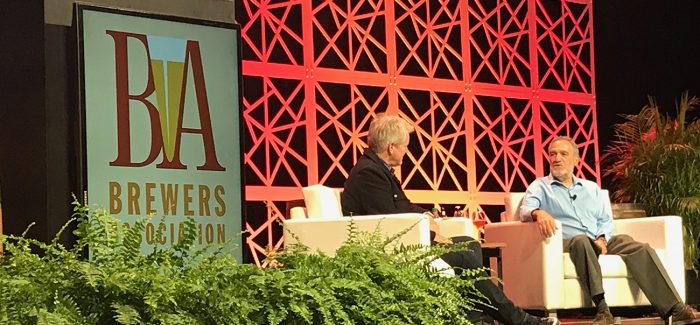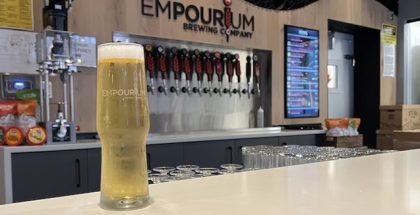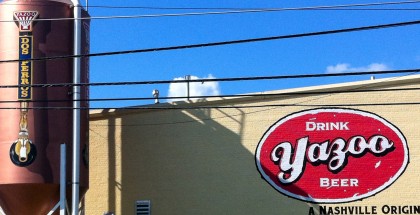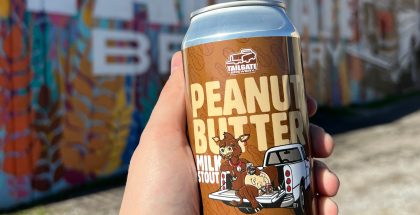Biggest Takeaways at the 2018 Craft Brewers Conference
Every seat was full on Friday morning’s Denver-bound Frontier flight out of Nashville—most passengers consisting of glassy-eyed or dozing beer industry professionals (likely on the 3rd or 4th day of wearing their embroidered brewery work shirts). This year’s Craft Brewers Conference, spanned the better part of last week from Monday through Thursday evening’s World Beer Cup awards ceremony. For many, this meant five full nights of beer-soaked, deep fried, Nashville-themed debauchery reuniting industry friends from all over the world.
Fun was certainly had in the forms of food, drink, and most likely a bit of hazy shop talk. But after returning back home on day six and collapsing on my couch, a thought ran through my mind: “this was fun, but it was a challenge to keep up with everything.” This sentiment probably should be the tagline for the (U.S.) brewing industry in 2018. Anyone who has even glanced at the Brewer’s Association’s 2017 industry growth statistics (or maybe just their own company bank statements) knows the craft landscape in the U.S. is morphing rapidly as supply and demand move toward equilibrium. Breweries and businesses who based their growth strategies on projected demand models from five years ago, are backpedaling or reeling as a result. Meanwhile, the Brewer’s Association (BA) has a message for those who aren’t passionate about the craft movement: disengage. This year’s CBC, as a result, was uber-focused on strategy and dissecting the complexity of the industry’s many moving parts. Below are some of the biggest trends and takeaways we noticed over early-morning cups of coffee, laps around the expo floor, and evening drinks at neighborhood breweries during the 2018 Craft Brewers Conference.
The Independent craft seal was everywhere, and the BA was REALLY pushing “We are Stronger Together” mantra.
The prevailing theme the Brewers Association strove to drive home throughout the week, was one of doubling down behind the “Independent Craft” label, and introducing a new catchphrase in “Stronger Together”. The prior should come as no surprise to anyone who has been following BA-sponsored beer festivals, where brewery pouring stations are now marked with independent seal stickers to denote a participating small and independent brewery. The seal greeted conference-goers via a massive banner by the main entrance of the Music City Convention Center and followed up with appearances on indoor TVs, signage that lined the streets of downtown Nashville, printed signage within the hall, t-shirts, buttons, and we’re a little surprised Paul Gatza didn’t get it shaved into his glorious mullet.

Tuesday’s keynote included several speakers including CEO Bob Pease and Left Hand Brewing founder and BA Chair, Eric Wallace who really drove the point home, echoing chants of “We are stronger together!” through enthusiastic grins. A video followed on the large screens, wherein no less than 15 industry professionals, looking directly into the camera, solemnly repeated the “Stronger Together” phrase.
Chairman Eric Wallace’s verbiage painted craft brewers as fighting for a noble cause “under direct threat” by Big Beer, whose “tactics are weapons used to marginalize us.” It was awkwardly amusing to think of the macro brewery representatives and macro acquisitions in that very same room, sitting through the BA’s fighting words.
That said, according to the BA, as of the end of the conference, they had seen another 100 brands adopt the seal, joining the over 3000 breweries who have already adopted.
Taprooms continue to be the strongest point of sale.
A focus on taproom sales is “pragmatic,” especially for small to mid-size breweries, who generate a large income percentage from profit margins of direct sales. The BA chalks this up to taprooms being community-centered places, oriented towards family, experiential and exciting for consumers.
In fact, Bart Watson, Chief Economist for the Brewers Association pointed out that breweries 4 years old or younger accounted for 76% of craft beer’s overall growth in market share last year. In fact breweries that were founded in 2013 or earlier grew by only 1.3% last year.
q With younger breweries predominantly depending on taproom sales to drive revenue, it seems evident that consumers are shifting their preferences toward visiting their local taprooms over purchasing six-packs to take home.
As a result, 2018’s CBC offered patrons TONS of sessions on taproom tactics including marketing, design, and music licensing techniques.
Diversity, activism and policy change continue to be hot topics in today’s current climate.
The BA appointed its first diversity ambassador, Dr. J. Nikol Jackson-Beckham, about a week prior to the conference. This came just one year after the BA announced the formation of its own diversity committee at CBC 2017. Dr. Jackon-Beckham led a session titled “A Brewery For All: Tactics For Being Inclusive and Building Diversity,” in which she gave a very direct speech tackling current brewery roles and paradigms (as they relate to diversity) and strategies to employ. Additionally, speaker Kelly McDonald also addressed the need to create a welcoming taproom environment for all backgrounds and races. And spoke on the importance of getting a better understanding of the underserved demographics by speaking to them to gain a better understanding their cultural perspective.
Sessions titled “Brewing with Purpose,” and “…What Politics and Pints have in Common” were both offered throughout the conference, most likely a reaction to the $73.4 million craft brewers donated to charitable causes in 2016 (up from $71 million in 2014). Congressman Peter DeFazio gave a talk on how to extend the 2018 excise tax elimination, and there was plenty of buzz on state legislation, like last year’s Georgia bill which finally allowed direct sales from breweries and distilleries.
Speaking of which, the tax beverage and modern reform act was pretty cool, right?
With 2018’s tax reform bill came an excise tax elimination many are probably aware of by now, particularly affecting small brewers (those producing 2M barrels or less annually) who will now pay only $3.50 per barrel, down from $7 per barrel. This excise tax was originally created to fund The Civil War, and its elimination is currently temporary and set to expire in two years. Overall, the BA considers this a win for the brewing industry and proof of what beer lobbying by Brewers Guilds and the BA can do for your business. The BA encourages breweries to fight to make this tax cut permanent by keeping and sharing records of revenue and expansion generated from the cut, or even by inviting local policymakers in for a beer!
Distributor/market politics are getting people very wound up.
As the distribution market becomes saturated, breweries are finding it more challenging to get fair representation and prices from their local distributors. Wholesalers are also at capacity, no longer able to focus as intently on individual brands because there are so many options in the market. The BA talked of concern over these issues, as well as unfair practices from multi-nationals who own or influence major distribution channels, swaying the market to favor their products and also seek to undercut pricing within the marketplace, so that consumers become used to paying bargain prices and balk at premium priced brands.
We’re seeing increased worldwide distribution and development of craft beer culture in countries outside The U.S.
Joining global markets is the new method of expansion. The BA reports that exports from the US were at an all-time high last year, increasing 3.6% for a total of 482,309 barrels valued at $125.4 million:

While higher demand in global markets makes exportation appealing to American breweries, it would be a shame for a business to underestimate this process. CBC sessions like “Craft Beer in China” and “TTB Compliance & Challenges When Exporting Your Beer” were well-attended and reps from the Brewer’s Association’s Export Development Program (started in 2004) were on hand to answer many eager and intricate questions.
Forget East coast vs. West coast—IPAs are our universal language.
As the saying goes, “wherever you go, there you are, ordering from a mostly-IPA beer menu.” Just kidding. Perhaps East or West Coast can speak to an IPAs’ region of origin, but consumer palates nationwide have had years-long insatiable thirst for hoppy beers with no sign of fatigue in sight, and menus at even the most micro of microbreweries reflect this. Case in point: Bearded Iris Brewing in Nashville offers almost exclusively hazy IPAs in their taproom, which turned out to be a happening spot for visitors and CBC events all week long.
…And with the sustained popularity of IPAs come another wave of new, inventive hops as well as different forms of hops.
With the sustained IPA craze comes a tangential movement—innovation and creativity in the hop industry. One example of this is cryogenic hops, developed by Yakima Chief—Hopunion. Cryo hops are frozen with liquid nitrogen, and the lupulin particulate is separated from the plant’s leaves and stems, leaving a concentrated powder. Another form of hop concentration gaining traction is hop oil extract, a compound of separated hop resins, alpha-acids or oils obtained through distillation of steamed hops. Hop oils come in bittering or aroma forms with only a relatively small amount used per batch (hoptech.com, for example, recommends approximately one 2-oz. bottle per barrel of beer). Hop oil is going mainstream in beers like Sierra Nevada’s Hop Hunter, while hop concentration methods allow for smarter and more efficient use of hops in beer, and saves breweries on shipping and storage costs!
Hop producers are also introducing this year’s new strains to the markets, and as always, the hop names don’t disappoint. If you’re a brewer, expect to see hops like Cashmere, Sabro, Pekko, Aloha, and Enigma (just to name a few) offered by your supplier.

Brewers Guilds are advocating for industry workers with a movement to provide insurance plans.
Sadly, we know too many brewery employees and even brewery owners who lack health insurance in Denver alone. Small to mid-size breweries seem to find employee coverage an unjustifiable cost more often than not, and intense market pricing forces some workers to choose between the cost of living and working in the Denver brewery scene and having insurance at all. The Colorado Brewers Guild is one state guild attempting to tackle this problem. They plan to open a full-service insurance agency, The Brewers Insurance Cooperative of Colorado, for CBG members looking for insurance in the commercial or professional realms, employee benefits, or even HR support. With enough participation, CBG hopes to eventually offer pooled workers comp and health insurance products, which would create more competitive plan pricing. This initiative is modeled after a brewery-specific insurance company created by California’s Craft Brewer’s Association. The Colorado Brewers Guild is set to offer additional details in the next month, with rumors that other states may soon be following suit!
Yes, industry growth has been (predictably) slowing, BUT…
Breweries that have opened since 2014 saw 916K bbl of growth, an increase of 52.6% growth, while those that formed pre-2013 only saw a growth of 285k bbl, or 1.3% growth. Why have breweries founded before the growth boom of 2014-2015 struggled to find the rate of expansion experienced by newer, fresher faces? One harsh reality is that the craft consumer is hard to pin down, inundated by the number of choices at their fingertips and easily seduced by the new, exciting and market-driven brands. It’s “harder to tell a single story,” says BA economist Bart Watson, citing more industry diversity and competition than ever before. Another interesting growth metric cited a 15% growth for brewpubs, 17% growth for microbreweries but only 1% growth for regional breweries in 2017. “If you don’t love [the industry], leave it,” said another slide from the BA, an organization never accused of speaking indirectly.
“If you don’t love [the industry], leave it.” – The BA
Statistics like these tested the nerves of conference attendees. One conference session, “Growing Into the Headwinds,” was so well-attended there was hardly even space to sit on the floor. Notably, in this session, David Walker (of Firestone Walker) used a metaphor comparing the state of the industry to running a race: “We’re running up a hill… I like a hill because at the top only the best runners are left” (paraphrased). Eric Ottoway, CEO of Brooklyn Brewery, also expressed a lack of concern for slow growth. “I would argue there aren’t headwinds at all,” he said, citing economic reality as a reason some breweries are struggling, “…we’re not immune to the laws of physics, gravity applies to us as well.”
In conclusion
The silver lining to all of this is that the industry is still VERY much alive and healthy (and in many areas abroad, only in its beginning stages). One panelist compared the restaurant failure rate (80% in 5 years according to Business Insider) to the craft beer industry’s failure rate in the past year: 3%. Touché. I’ll leave on the same phrase as the BA in their state of the industry talk: “craft beer sales are at an all-time high.” For those who innovate, market wisely, and persevere in the coming years, there will be pie to go around.








Submit a Comment